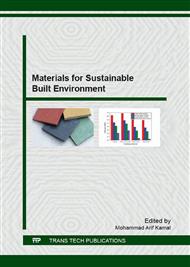p.1
p.9
p.17
p.27
p.38
p.45
p.54
p.66
Simulation of Various Wall and Window Glass Material for Energy Efficient Building Design
Abstract:
Buildings consume huge amount of energy for forced ventilation and artificial day lighting. Use of appropriate material combinations for walls and window glass can help in reducing energy consumption for cooling and lighting. This paper presents the thermal properties of four building materials such as, laterite stone, dense concrete, burnt brick and mud brick. It also presents the experimentally measured optical properties of glass materials such as, clear glass, bronze glass, green glass and reflective. In this study building of size 5m X 5m X 3.2m with four wall materials and four glass materials were designed using design builder software. The thickness of the wall was considered as external wall with thickness 0.22m. All the walls covered with cement plaster on either side. Roof of the building is made of reinforced cement concrete and floor is dense concrete. Thermal analysis was carried out using by Energy plus software. Single sized glass windows were placed in south direction (Due to less heat gain in south direction) for Mangalore city (12.870N, 74.880E), Karnataka, India. Different window to wall ratios (20%, 40%, 60%, 80% and 100%) were maintained for buildings. Total eighty building models were investigated for heat gain into buildings. From the results, it is observed that irrespective of the window to wall ratio, mud brick walls with reflective window glass were observed to be energy efficient from the lower heat gain point of view, and laterite stone wall building with clear glass windows were observed to be the worst due to their higher heat gain values. At 60% window to wall ratio mud brick walls with reflective window glass have 24.93kWh heat gain and dense concrete walls with clear glass have 32.9 kWh heat gain. The results of the study help in establishing the best combination of wall and glass materials for minimum heat gain into buildings.
Info:
Periodical:
Pages:
9-16
Citation:
Online since:
May 2016
Price:
Сopyright:
© 2016 Trans Tech Publications Ltd. All Rights Reserved
Share:
Citation:


